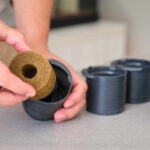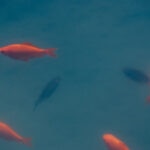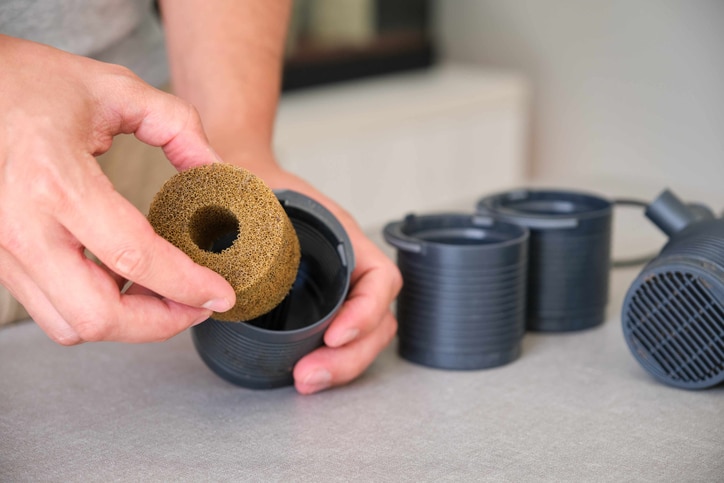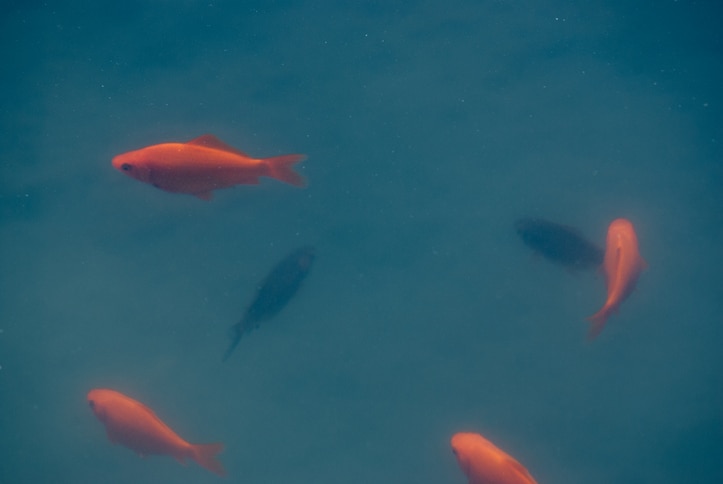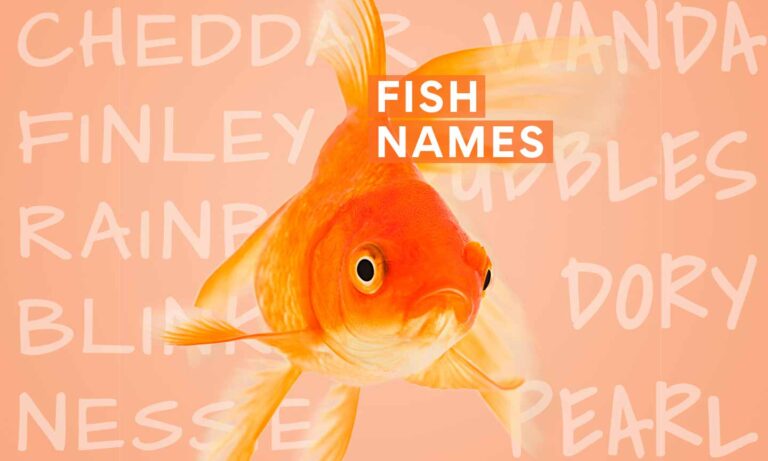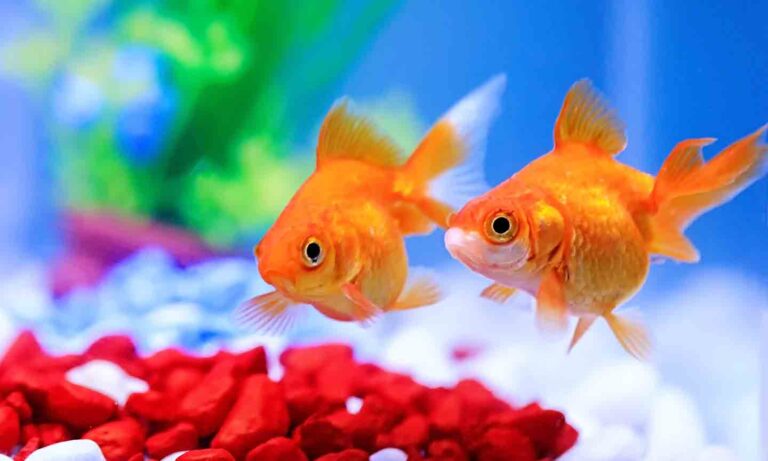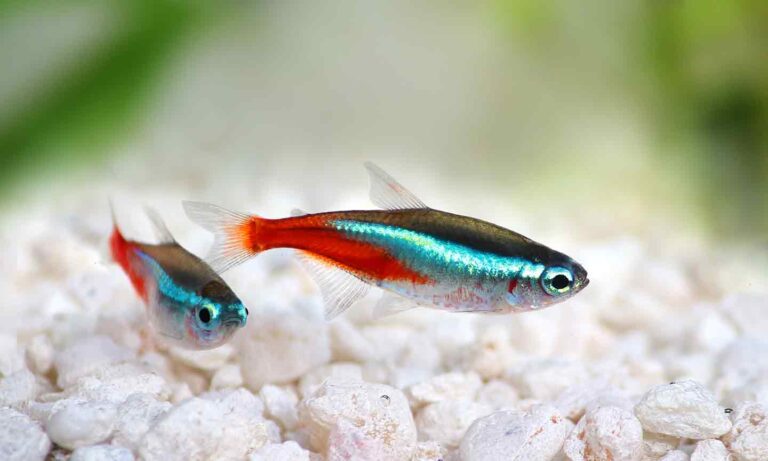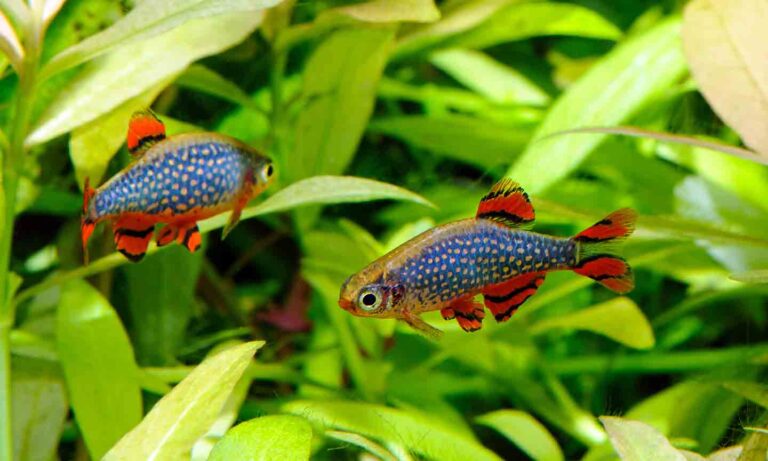Fish Parasites
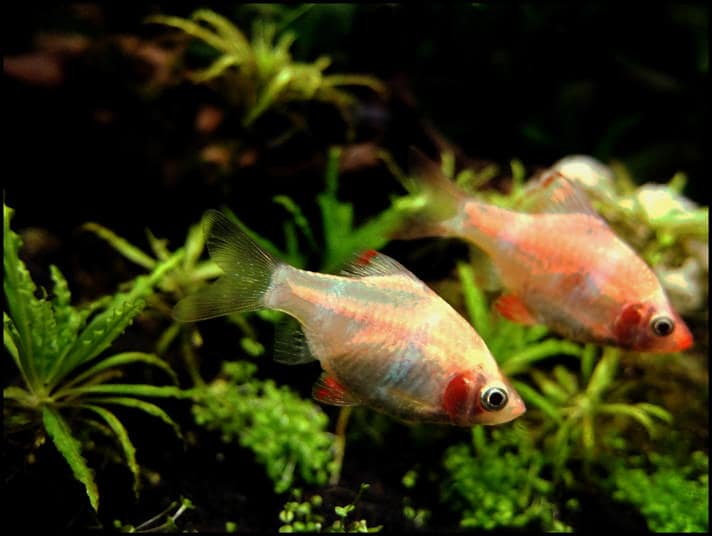
Photo by Chewy
Parasites are a group of organisms that may or may not cause illness in aquarium fish, depending on a number of factors. Before we learn about the different fish parasites, let’s find out exactly what a parasite is.
Parasites have arisen by evolution from what were free-living animals (animals not living on or in another animal, and not reliant on another to draw their nourishment). They often resemble their ancestors a good deal, but have become better adapted for a parasitic life. Some parasites have developed organs, such as suckers for hanging on to their hosts. Many lay tremendous numbers of eggs because the chances that any one egg will infect a new host are incredibly small. Parasites have generally changed biochemically and immunologically, so they can survive inside another organism and not be digested or killed. Some of them depend on their hosts for compounds that their ancestors could synthesize.
Some parasites are harmful to their hosts, others are not. A parasite that might be harmful if present in large numbers might not be harmful if just a few have parasitized the host.
The Two Types of Parasites
Parasites are typically divided into two groups: ectoparasites, external parasites that live on the outside of a tropical fish host (including the gills, mouth, skin and fin surfaces), and endoparasites, which live in the tissues, blood and/or organs (including the gastrointestinal tract). Interestingly, we still don’t know exactly how intestinal parasites manage to survive without being digested along with the other contents of the intestinal tract. As you can imagine, the inside of the gastrointestinal tract is a pretty inhospitable place to live — it is full of acids and enzymes deigned to digest anything passing through it.
Some parasites are transmitted directly from fish to fish, such as some ectoparasitic protozoa and skin/gill flukes. The life cycles of these parasites may also include a free-living phase, when they can be found in the water or aquarium substrate. The life cycle of such parasites is called a direct life cycle.
Other larger parasites often have complex life cycles involving two or more hosts, including a fish. This is called an indirect life cycle. For example, the spiny-headed worm attaches to the intestinal wall of a tropical fish (the definitive host), and after expelled by the fish defecating, the worm’s eggs are eaten by freshwater shrimp (the intermediate host), which are in turn ingested by another tropical fish.
It is important to know the difference between life cycles, because this will have an effect on treatment methods and whether you will succeed when treating parasites.
Preparing For Battle
Find a veterinarian who is knowledgeable about aquatic medicine and is willing to work with you. If you can’t find such a vet, try to find one who is at least interested in aquatic medicine, but perhaps a novice, and encourage him or her to work with you. Almost all of the major veterinary conferences offer courses in aquatic medicine, and there are many texts and Internet sites that offer excellent information for veterinarians.
Many veterinary labs offer free consultations to the veterinarians who use them, and these can be a great source of information. Parasitologists are also valuable in helping to diagnose certain parasitic problems. Armed with these resources, as well as a basic knowledge of infectious diseases, a good microscope and a pathologist who can read fish samples, you and your vet can work together to diagnose and treat fish problems.
If you have an infected tropical fish, your vet can attempt to diagnose the problem by utilizing stool samples, skin scrapings and lesion culturing, or through biopsy of tissue for histopathology (this entails examination of tissue under a microscope by a trained veterinarian after the sample has been sliced into very thin specimens and stained with agents to identify structures). In some cases, it may be more helpful diagnostically to sacrifice a single fish showing signs in order to accurately identify the problem, especially in cases that involve pet retailers, breeders and aquariums containing valuable fish. A single sacrifice such as this may save many more fish in the long run.
Causes and Cures
Clinical signs of parasitic disease in tropical fish can be vague. A sick fish may be seen swimming alone, or it may swim more slowly and/or on its side. The gills may move more rapidly. The fins may be clamped or droopy, and the fish may be losing weight. There may be white spots on the skin or gills, or the tropical fish may rub against aquatic plants, ornaments or gravel. Some tropical fish appear bloated.
Most parasitic diseases occur as a result of poor water quality. Most parasitic organisms are opportunistic and may be present all the time in the aquarium or on the fish in low numbers, and only cause disease when the tropical fish is stressed. The number of tropical fish in an aquarium, water temperature, pH, lighting, type of filtration system and water chemistries all influence the health of the fish.
Another common reason for parasitic outbreak is inadequate (or a total lack of) quarantine procedures for new tropical fish prior to introducing them into your aquariums. Many diseases do not show up for two to three weeks following transport, and unfortunately this can result in serious problems being introduced into an established aquarium. A quarantine aquarium can be as simple as a bare aquarium outfitted with a heater and sponge filter. Three to six weeks of quarantine should allow owners to identify any sick tropical fish prior to introducing them into the community aquarium. During quarantine, weekly treatments with formalin (25 mg/L) are reasonable and likely to avert serious illness in many cases.
At the first sign of illness, use a test kit to make sure the values are appropriate for the types of tropical fish you are keeping. Also perform a partial water change, which is an important safety measure. If possible, move any ill fish into an isolation aquarium to more closely observe them and prevent the possible spread of any infectious organisms.
Ich: The Most Common Parasite
By far, the most commonly encountered parasite is the organism responsible for ich. Ich is also known as white spot disease, due to the appearance of fish infected with this organism. It is caused by the ciliated one-celled protozoan Ichthyophthirius multifiliis.
Often, ich shows up as small white spots on a fish’s skin, fins and gills. Each spot is caused by a parasite that lies just beneath the fish’s transparent skin (the epithelium). The small spots measure up to 1 millimeter in diameter, but with severe infections several parasites may coalesce to form irregular white patches. Heavily parasitized fish will exhibit many white spots, will often scratch against rocks and gravel, and they may show increased gill movements. Fish heavily parasitized with ich may also develop secondary bacterial infections because the slime coat and epithelium are compromised, allowing bacteria in the water to invade the skin. The organisms feed on body fluids and cells, and a thin capsule forms over each parasite while it is under the skin.
Ich can infect virtually all freshwater fish, including both coolwater and tropical species. The life cycle contains both free-living and parasitic stages. Mature parasites, feeding on the host tissues, break through the skin and fall away from the fish, where they form cysts on the floor of the aquarium. This is the reproductive stage, and each cyst can divide many times, eventually producing many hundreds of “swarmers,” as they are called during the infective stage. These exit the cysts and swim off to find a fish host. If they do not find a host within several days, they die.
The time necessary to complete the life cycle depends on the water temperature of the aquarium. The higher the water temperature, the faster the life cycle. At 70 degrees Fahrenheit, it takes about three or four days to complete the life cycle, whereas at 50 degrees it may take up to five weeks. At low temperatures, the parasite may become dormant for considerable lengths of time.
There are a number of effective treatments for ich. Because the organism is found beneath the outermost layer of skin, many treatments are actually aimed at controlling the free-living stages. Diagnosis and treatment should be instituted as soon as the problem is discovered, as prompt treatment is imperative in controlling this organism. It can be introduced with fish, live aquatic plants and live fish food, so proper quarantine can often prevent it from contaminating a community aquarium.
Now that we know the basics about parasites and their life cycles, in the next issue, we will describe many of the more commonly diagnosed parasitic diseases. The physical appearance of the parasitized fish may help in diagnosing the specific organism involved, and other methods of testing will be discussed. Treatments for specific parasitic diseases will be presented, although it is still recommended that you seek the help of a qualified veterinarian or aquaculturist. Many commercially available treatments now are more broad spectrum, which means that they can treat many different types of organisms that cause disease. While this may be helpful when a specific diagnosis is not made, medications that treat a number of diseases may mean that the treated fish are given unnecessary medication.
We’ve learned about the life cycles of common tropical fish parasites. Before we discuss treatments, let’s do a brief review of a few key ideas that help us understand what exactly we are dealing with when it comes to parasites.
Types of parasites
Parasites are typically divided into two groups: ectoparasites, which live on the outside of a tropical fish host (including the gills, mouth, skin and fin surfaces); and endoparasites, which live in the tissues, blood and/or organs (including the gastrointestinal tract).
Types of hosts
A definitive host is one that harbors the sexual adult stage of the parasite, while an intermediate host harbors an asexual or larval stage. A parasite vector is an arthropod or other invertebrate that transmits the parasite from one vertebrate host to another. Infection and infestation. Infection is parasitism by an internal parasite, while infestation is parasitism by an external one.
Life cycles
Parasites with a direct life cycle are transmitted directly from one fish to another, and may also include a free-living phase when they may inhabit the water or substrate. On the other hand, an indirect life cycle refers to a complex life cycle involving two or more hosts, including a tropical fish (e.g., a fish and a shrimp), and is often characteristic of larger parasites. We’ve already taken a close look at ich, the white spot disease caused by Ichthyophthirius multifiliis. As noted, ich has both free-living and parasitic stages, and even though there are many different treatments available, the specific treatment must be chosen on the basis of the type of tropical fish infected and the environment in which they are maintained. When it comes to treating fish parasites, there are some medications commercially available that work well, but others can only be prescribed by a veterinarian.
Drugs or chemicals placed in the water are commonly referred to as “bath” treatments. Drugs delivered orally are generally mixed in the food and are meant to deliver systemic effects. Bath treatments are the most variable, in that a specific concentration of a chemical is placed in the water for a specific length of time. As a rule, lower concentrations are used for longer periods of time or vice versa.
Ich Treatments
I’ve described the parasite that causes ich. Now let’s examine in more detail how to get rid of it.
Salt (plain old sodium chloride), which is often overlooked in favor of other drugs and chemicals often thought to be better and more powerful, is one safe and very effective method of treating ich, as well as many other external parasites. For most purposes, uniodized table salt is adequate, though there is nothing wrong with using aquarium salt specifically sold for that purpose, such as sea salt, or solar salt, salt sold for consumption by livestock and kosher salt.
As an aid to osmoregulation, salt may be added at a concentration of 2 to 3 parts per thousand (1 ppt = 1 tsp/gallon, 3 ppt = 1 tbsp/gallon; for ponds, use 1 pound per 100 gallons). This concentration is safe for most tropical fish, and protozoa cannot live in this level of salinity. As a treatment for ich and some other protozoa, infested fish should be dipped in saltwater at 30 ppt (which is the salinity of seawater) for 30 seconds up to several minutes – or until the fish rolls on its side. The tropical fish should then be placed back in normal-salinity water.
To mix this solution, use aquarium water and dissolve 30 teaspoons of salt per gallon. Place the fish into this water, monitoring it the entire time. Repeat this process once daily for three days, with a 30- to 70-percent aquarium water change between treatments. This treatment is different from most others, in that it is used to treat organisms in the skin of the fish and not the free-living stages found in the aquarium.
Lower doses may be used as a continuous bath in the aquarium fish. At 5 to 10 ppt, tropical fish can survive for several hours to several days, and this will effectively kill the ich organisms. A bath of 4 to 5 ppt will break the ich life cycle and will kill anchorworms and lice, as well. Freshwater fish can live in this salinity for up to four weeks. A salinity of 5 ppt or greater will usually kill live plants.
Formaldehyde (formalin) at 37 percent may be used as a medicated bath as a treatment for ich and some other protozoa. Use a bath for 12 to 24 hours dosed at 1.0 milliliter (ml) per 10 gallons of water. This is repeated for three treatments, every three days. Partial water changes (30 to 70 percent) should be performed between treatments. Formalin may be added to the display aquarium, but because it is so toxic, it’s preferable to restrict its use to a treatment aquarium. Formalin removes oxygen from water, so the treated water must be well aerated. It is a carcinogen (capable of causing cancer), too, so anyone using this chemical must be educated about safe handling. Formalin supplied for use by veterinary clinics to preserve tissues is too diluted and is not approved by the Food and Drug Administration. Formalin should only be used after consulting with a veterinarian about its use. Malachite green is another treatment for ich. Dosed at 0.1 to 0.15 ppm, it may be used as a bath for 12 to 24 hours. This is usually repeated daily for three days, with a 30- to 70-percent water change between treatments.
Another ich treatment is Victoria green and acriflavin. These chemicals are available commercially as tablets that fizz as they dissolve. This formulation is also designed to prevent secondary bacterial infections. One dose may be all that is necessary. However, you should change 25 percent of the water every 24 hours if additional doses are needed. Remove activated carbon from the filter during treatment.
For some, copper is the treatment of choice for ich. The safe use of copper depends on the total alkalinity of the water. If total alkalinity is less than 100 milligrams per liter (mg/L), the use of copper sulfate is not recommended. Copper must be carefully dosed. It will also kill invertebrates and live plants.
Increase the fish aquarium temperature during any treatment. This is to speed up the life cycle of the organisms, because treatment is aimed at killing them in their free-living phase.
Trichodina and Related Protozoa
Other protozoal parasites found externally are Ichthyobodo/Costia, Trichodina and Chilodonella, along with monogenetic flukes (such as Gyrodactylus). The most obvious symptom of this is a gray-white film of excess mucus that develops over the body, and is especially noticeable over the eyes or areas containing dark pigment on the skin. Along the flanks, reddened areas may occur, and sometimes the gills swell up. Tropical fish may move rapidly and flash (swim erratically), and they may have respiratory problems. However, as the infestation progresses, the fish become listless and lie on the bottom of the fish aquarium, occasionally scratching against rocks or aquarium ornaments. Usually, excessive mucus is caused by more than one organism.
Trichodina and the related protozoa usually cause problems in tropical fish that are overcrowded, stressed or suffering from poor husbandry. Trichodina attaches temporarily by an adhesive disc to the skin. In large numbers, they damage the skin, becoming parasitic and feeding on it. Ichthyobodo attaches to the gills or fins, and feeds on cytoplasm, causing hyperplasia (an abnormal increase in volume of a tissue or organ caused by the formation and growth of new normal cells) of the epidermis and destruction of goblet cells (solitary, mucus-secreting cells).
Initially, these should be treated with the same therapy as for ich—these are protozoal parasites (except for the flukes). If the fish have not improved within five to seven days, do a 50-percent water change, and treat with formalin or an organophosphate insecticide used for removing monogenetic flukes (more on these later).
Hexamita and Spironucleus
Hexamita and Spironucleus are two other protozoal parasites commonly found in the intestinal tract of some freshwater fish, although systemic infections can occur. Hexamita is also known as “hole in the head disease.” Small holes appear in the body, especially the head region, and often strings of mucus trail from the lesions. Lesions may also develop at the base of the fins and near the lateral line. They have a direct life cycle, and are principally acquired by oral ingestion of trophozoites (the active, motile feeding stage of a sporozoan parasite) or cyst stages.
In addition to skin lesions, fish often go off their food and develop a hollow-bellied appearance. They also typically have stringy, off-color feces. Hexamita often exist at low levels in the intestines of tropical fish, especially cichlid fish (including discus, angelfish and oscars) and gouramis. If conditions in the fish aquarium include stress, overcrowding, low oxygen levels, improper water parameters, changes in temperature or poor diet, the parasites can multiply, and the fish may then develop signs of systemic disease.
The best way to treat Hexamita infections is with medicated food – if the fish are still eating. For both Hexamita and Spironucleus, metronidazole can be used and is available commercially in fish food flakes. However, because infected fish often do not feed, they usually won’t ingest an effective dose. In such cases, a bath of metronidazole can be used instead, immersing the fish for six to 12 hours, with 250 mg of metronidazole per 10 gallons of water. Metronidazole tablets, capsules or liquid can be used to prepare the bath.
Several courses of treatment may be necessary to successfully control these parasites. Of course, as with all infectious organisms, it is always best to prevent introduction to the fish aquarium in the first place by quarantining and prophylactically treating all new stock, as well as maintaining your fish in the most healthful manner possible.
Velvet Disease
A parasitic single-celled organism known as a dinoflagellate (Piscinoodinium, commonly called Oodinium) is responsible for velvet disease. This parasite has a direct life cycle, and has free-living and parasitic stages. The obvious symptoms are a yellow-gray coating to the scales, skin and fins. Fish may flash and show increased gill movements. In advanced cases, the fish will become anorexic and float motionless in the water, and the skin may peel away in strips.
A novice may confuse this disease with ich, but fish with velvet appear as if they are sprinkled with gold dust, hence the common name of “gold dust disease.” This parasite moves from fish to fish with a flagellated spore, and can live off the fish for at least 24 hours, and probably longer (up to several days).
Velvet is usually introduced with new fish and may develop into a serious problem. Heavy infestation on the gills may kill fish without causing other obvious signs of the disease. It is most often found among some anabantids, killifish and goldfish. The parasite may establish itself in the intestinal tract of fish, making treatment more difficult, and long-term control of the parasite can be quite frustrating.
Treatment with ich or velvet remedies may be used. If the fish are salt tolerant, a prolonged (see the “Ich Treatment” section for suggested durations) salt treatment using 1 teaspoon of salt per 5 gallons of water can be used to eradicate the parasite. Interestingly, because the parasites use photosynthesis, keeping the aquarium relatively dark can help during a serious outbreak.
Neon Tetra Disease
Another protozoal parasite, Pleistophora, is responsible for neon tetra disease. A range of fish species are susceptible, but this parasite seems to affect many tetras in particular. Zebra danios and some barbs are also commonly affected by a similar disease.
Heavily infected tropicalfish will exhibit a loss of coloration (especially the red stripe on neons), unusual swimming behavior, spinal curvature, emaciation and frayed fins. Treatment has been attempted with a number of drugs, but none have been completely effective. Some medications, such as combination products on the market that contain an antiprotozoal and antibiotic, will help control secondary bacterial infections.
Monogenetic Flukes
Monogenetic flukes are flatworms that are usually found as ectoparasites of fish. They often have a hooked attachment organ and a simple life cycle, and are just barely visible to the naked eye. They often feed on skin and gill tissue, but usually only cause problems if found in large numbers. Clinical signs are flashing and skin problems.
Treatment with formalin, praziquantel, Trichlorofon (dimethyl phosphate) or salt baths are effective. Formaldehyde can be used as a bath for 12 to 24 hours at 20 to 25 ppm (mg/L), repeated every three days for three treatments, with 30- to 70-percent water changes between treatments (same regimen as for ich).
Praziquantel is dosed as a bath for three to six hours at 5 to 10 mg/L repeated three times. In between each dosage, change 30 to 70 percent of the water. Praziquantel is now available in several commercially prepared tablets.
Trichlorofon is used as a bath for one hour at 0.25 to 1.0 ppm repeated daily for three days, with 30- to 70-percent water changes between treatments. A salt bath can be a four to five-minute dip, dosed at 30 to 35 grams/L repeated daily for three treatments, with 30- to 70-percent water changes between treatments.
Digeneans
Digeneans are endoparasitic flukes that have two suckers, one at each end. They have an indirect life cycle, with tropical fish acting as both intermediate hosts (carrying metacercaria larvae) and final hosts. Adult digeneans are usually found in the gastrointestinal tract, while the larvae (which may be encysted) can be found throughout the body and cause problems if they invade such organs as the eyes or heart in high numbers. The larval stages of digenetic fluke parasites cause black spots in aquarium fish.
Praziquantel is the treatment of choice as a bath for three to six hours, dosed at 5 to 10 mg/L, repeated for three doses, with 30- to 70-percent water changes between dosing. This drug may also be dosed in fish food at 5 mg/kilogram of fish.
Tapeworms and Roundworms
Tapeworms are endoparasites, with adult tapeworms living in the digestive tract. Tapeworms are most common in newly imported or wild-caught fish. They have an indirect life cycle, with fish serving as both intermediate and final hosts. There is a public health concern because some tapeworms can infect humans. Signs of tapeworms may be a swollen abdomen and a fish that appears to be wasting away. Affected fish may have difficulty swimming, as well.
Praziquantel can be used to remove tapeworms from the intestinal tract (same treatment regimen as described in previous digeneans section) but will not eliminate those residing within the body cavity. Repeating treatment with praziquantel may be necessary to completely eradicate tapeworms.
Be aware that some live fish foods, such as cyclops and water fleas, can be the intermediate hosts of many of these parasites, unless you are certain the fish food items come from a fish-free water source.
Roundworms (also called nematodes) may also be found inside aquarium fish. They have complex indirect life cycles, and fish can serve as both intermediate and final hosts. Nematodes can cause problems to tropical fish (and also to humans who become infected by eating raw or poorly prepared fish). Roundworms are reddish-brown in color and vary in size. In severe infections, they may be seen protruding from the vent. Nematodes can be found in the digestive system, swim bladder and body cavity.
Treatment involves breaking the life cycle and using appropriate drugs such as fenbendazole, which is dosed in fish food for three days at 200 mg/100 grams of fish food. It may require several rounds of treatment, in addition to eliminating any intermediate hosts and improving general hygiene to remove infective stages. Piperazine can be used to treat livebearers with Camallanus nematodes. Mix 25 mg piperazine citrate with 10 grams of flake food, and feed to fish for five to 10 days. A repeat course of treatment is recommended 10 to 14 days later (dosed at 50 to 100 mg/kilograms of body weight).
Fish Lice, Gill Maggots and Anchor Worms
Some crustaceans are parasitic to fish, including the fish louse Argulus and the gill maggot Ergasilus. Both of these parasites are usually found on newly imported fish. Because they suck blood, they can transmit certain infections between fish.
The fish louse attaches itself to the skin and fins by means of twin suckers, and feeds on the blood of the host. The intense irritation may cause fish to flash, and heavily infested tropical fish may even jump out of the water. Red lesions occur where the lice have attached, and this opens the skin up to secondary bacterial and fungal infections.
Gill maggots are usually found attached to the gills, gill covers and inside the mouth. They are several millimeters long, and the common name refers to the adult females, with their prominent, whitish, “maggotlike” egg sacs. The male does not become a parasite. Heavy infestation can result in severe gill damage, emaciation, anemia and death.
Treatment requires an organophosphate insecticide such as dimethyl phosphate (also called phosphonate), Trichlorfon and Dimilin. The drug can be applied to a backyard pond or aquarium to eradicate both adult and juvenile crustacean parasites. Baths of Trichlorfon and Dimilin are both effective. Dimilin may be used as a bath for 48 hours, at 0.01 mg/L, repeated up to three times, and Trichlorfon can be used as a bath for one hour at 0.25 to 1.0 ppm, repeated up to three times.
Anchor worms are another crustacean parasite, elongated with two egg sacs at the rear end. They usually embed in the muscle of the body wall and often penetrate as far as the internal organs. A raised ulcer usually develops at the point of attachment, and secondary infections often occur at that site. Heavy infestations may cause weight loss and death.
Anchor worms don’t typically occur in aquariums. They are most often a problem with newly imported tropical fish and in garden ponds during the summer. Male anchor worms have a short life span and die after mating; females are usually seen attached to the fish host. Eggs hatch to produce free-living juvenile parasites, which eventually molt to produce adult stages. The juvenile stages can live without a host for at least five days.
As with other crustacean parasites, organophosphate insecticides are used to eliminate the free-living juvenile stages. Remove adult worms with a forceps and treat the site with a suitable antiseptic. Remove parasites weekly until no more adult worms are found.
Conclusion
It’s impossible to discuss every type of parasite that can attack freshwater fish, but those discussed in these two articles are the most commonly encountered. Please remember that prevention is always better than trying to treat and cure problems, and quarantining is your best way to protect your established fish.
Posted by: Chewy Editorial
Featured Image: via Katty Fe/Flickr
